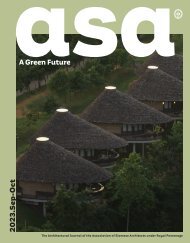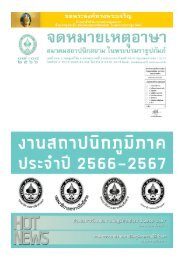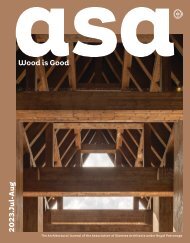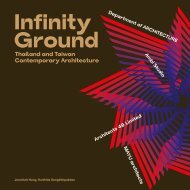ASA CREW VOL.4
Create successful ePaper yourself
Turn your PDF publications into a flip-book with our unique Google optimized e-Paper software.
AUSTRALIAN EMBASSY : The Inspiration<br />
Asst.Prof. Dr.Rittirong Chutapruttikorn<br />
Dean, School of Architecture, Bangkok University<br />
“When I was an architect student decades ago, I<br />
studied this building through the photos which my<br />
teacher showed and learned about the structure of the<br />
building such as waffle slabs. Now, almost 20 years past,<br />
I can see more other things that are hidden under the<br />
architect’s concept, like the way he applied Thai architectural<br />
intellect with the international architecture and<br />
merging the building with its surrounding.”<br />
ภาพ : วงศ์วิศว์ ไชยรักษ์ / Photo Credit : Wongwiss Chaiyarux<br />
ภาพ : วงศ์วิศว์ ไชยรักษ์ / Photo Credit : Wongwiss Chaiyarux<br />
ภาพ : วงศ์วิศว์ ไชยรักษ์ / Photo Credit : Wongwiss Chaiyarux<br />
4 2 3 1 5<br />
1 ผศ.ดร.ฤทธิรงค์ จุฑาพฤฒิกร<br />
คณบดีคณะสถาปัตยกรรมศาสตร์ มหาวิทยาลัยกรุงเทพ<br />
“เมื่อครั้งที่เป็นนักเรียนสถาปัตย์ ผมได้มีโอกาสศึกษา<br />
แนวคิดทางสถาปัตยกรรมต่างๆ ของที่นี่ผ่านภาพที่อาจารย์<br />
นำเสนอ เช่น การใช้ Waffle Slabs ซึ่งล้ำสมัยมากๆ ในเวลา<br />
นั้น วันนี้ผ่านมากว่า 20 ปี ผมเพิ่งได้เข้ามาเห็นอาคารจริง<br />
และได้เห็นแนวคิดของสถาปนิกหลายๆ อย่างที่ซ่อนอยู่<br />
ที่ประทับใจมากคือการนำเอาภูมิปัญญาไทยเข้ามาประยุกต์<br />
กับความเป็นสากล ซึ่งทำให้สภาพแวดล้อมกับอาคารเป็น<br />
ส่วนหนึ่งของกันและกัน การออกแบบพื้นที่เชื่อมต่อระหว่าง<br />
นอกอาคารกับในอาคาร หรือที่เรียกกันว่า Grey Space ใน<br />
หลายๆ จุด เช่น ระเบียงภายในลานกลางอาคารที่ปลูกต้นไม้<br />
ใต้ชายคาโดยรอบ ชานเชื่อมระหว่างสวนและห้องนั่งเล่น<br />
ภายในบ้านพักท่านทูต พื้นที่เหล่านี้แสดงถึงลักษณะไทยที่<br />
สถาปนิกดึงออกมาใช้ได้อย่างมีประโยชน์เหมาะสมกับ<br />
ภูมิอากาศเขตร้อนของบ้านเรา”<br />
2 ผศ.ดร.อันธิกา สวัสดิ์ศรี<br />
ผู้ช่วยอธิการบดี สถาบันเทคโนโลยีพระจอมเกล้าเจ้าคุณทหารลาดกระบัง<br />
“ประทับใจสองเรื่อง คือ เรื่องของรูปแบบอาคาร ซึ่งเป็น<br />
แนวราบ เชื่อว่านำเอาบริบทของพื้นที่ในเมืองของกรุงเทพฯ<br />
ย่านสาทร ซึ่งยังคงมีพื้นที่เพียงพอส ำหรับอาคารและบริเวณ<br />
พื้นที่สีเขียวรอบๆ เมื่อกว่า 40 ปีที่ผ่านมา อาคารมีการเปิดรับ<br />
เอาอากาศจากภายนอกถ่ายเทเข้ามาภายในอาคาร และ<br />
สามารถมองสภาพแวดล้อมภายนอกจากภายในอาคารได้ดี<br />
สังเกตว่า รูปแบบอาคารของสถานทูตแห่งใหม่เปลี่ยนไป (ตั้ง<br />
อยู่ที่ถนนวิทยุ) ที่รูปแบบเริ่มปิดล้อมมากขึ้น แน่นอนเพราะ<br />
บริบทของกรุงเทพฯ เปลี่ยนไปมาก ที่ตั้งของสถานทูตถูกล้อม<br />
ด้วยอาคารสูง สภาพอากาศ และการจราจร ต่างไปเยอะ น่า<br />
สนใจที่การออกแบบไม่ได้มีเพียงปัจจัยการใช้งานที่มาจาก<br />
ภายในเท่านั้น การเปลี่ยนแปลงบริบทรอบๆ และปัจจัย<br />
ภายนอกเข้ามามีส่วนกำหนดรูปแบบอาคารอย่างเห็นได้ชัด<br />
ส่วนความประทับใจอีกเรื่อง คือ ความรู้สึกของคนที่อยู่ที่นี่<br />
มานาน มีความผูกพันกับสถานที่ ส่วนหนึ่งเนื่องจากเวลา<br />
ผ่านไปหลายสิบปี แทบทุกพื้นที่ของอาคารยังคงตอบสนอง<br />
พฤติกรรมและความต้องการได้ดี”<br />
3 ผศ.ดร.ธนธร กิตติกานต์<br />
อาจารย์ประจคณะสถาปัตยกรรมศาสตร์ มหาวิทยาลัยกรุงเทพ<br />
“แวบแรกที่เดินเข้ามาที่นี่ผมรู้สึกเสียดาย แต่ก็เข้าใจถึง<br />
บริบททางสังคมและเศรษฐกิจในช่วง 40 ปีที่ผ่านมา ที่ส่งผล<br />
ให้ย่านนี้กลายเป็นย่านส ำนักงานและเป็นศูนย์กลางเศรษฐกิจ<br />
สิ่งที่ผมประทับใจในอาคารหลังนี้คือความเข้าใจใน<br />
สถาปัตยกรรมไทยของสถาปนิก เพราะแม้ว่าในภาพรวม<br />
จะดูเป็นงานยุคโมเดิร์น แต่ในหลายๆ รายละเอียดกลับ<br />
แสดงถึงรสนิยมไทยอย่างไม่เคอะเขิน เช่น การเลือกใช้<br />
กระเบื้องดินเผาที่มีสีไม่เท่ากันมาประดับผนังอาคาร และ<br />
การสอดแทรกพื้นที่ระเบียงหรือนอกชานให้ร่มรื่นไปด้วย<br />
ต้นไม้ เป็นต้น”<br />
4 อ.ภิรายุ มารศรี<br />
อาจารย์ประจคณะสถาปัตยกรรมศาสตร์ มหาวิทยาลัยกรุงเทพ<br />
“ผมประทับใจพื้นที่ภายในที่ว่างของอาคารที่เปิดโล่ง<br />
ตรงกลาง ซึ่งแสดงออกถึงความเป็นไทยที่ชัดเจน นับเป็น<br />
โครงสร้างอาคารแบบ Waffle Slabs ที่กว้างมากแห่งหนึ่ง<br />
เท่าที่ผมเคยเห็น รวมถึงการเชื่อมต่อพื้นที่ระหว่างในร่มและ<br />
กลางแจ้งที่ไม่ได้ปิดทึบเหมือนอาคารทั่วไป เป็นอาคารที่ให้<br />
ความรู้สึกถึงความอ่อนน้อมถ่อมตัว รวมไปถึงรายละเอียด<br />
ของหินคอนกรีตที่สภาพดูเก่า แต่ผ่านไป 38 ปียังคงสวยงาม<br />
และร่วมสมัย”<br />
5 อ.นัจพร โกศลานันต์<br />
อาจารย์พิเศษประจคณะสถาปัตยกรรมศาสตร์ มหาวิทยาลัยกรุงเทพ<br />
“รู้สึกทึ่งกับการใช้วัสดุของที่นี่ ถ้าเทียบว่าอาคารสร้างขึ้น<br />
เมื่อเกือบ 40 ปีที่แล้ว ในห้องครัวปูกระเบื้องยางที่คงทน การ<br />
เลือกใช้วัสดุ UPVC รวมไปถึงรายละเอียดเทคนิค เช่น การ<br />
เซาะร่องประตูการจบงานของช่างฝีมือที่ประณีตมากๆแน่นอน<br />
40 ปีก่อนเราจะไม่มีทางเห็นรายละเอียดของวัสดุเหล่านี้ ได้เลย<br />
เพราะบ้านเราเพิ่งมานิยมใช้แนวคิดเหล่านี้เมื่อ15 ปีที่ผ่านมา<br />
นี่เอง นั่นเพราะการก่อสร้างทั้งหมดยึดมาตรฐานจากออสเตรเลีย<br />
อีกหนึ่งความประทับใจคือการใช้รูปทรงเรขาคณิตในงาน<br />
สถาปัตยกรรมที่ชัดเจนมาก เช่น การเจาะรูข้างหน้าอาคาร<br />
เป็นวงกลม นับเป็นความทันสมัยอย่างมากในสมัยนั้น”<br />
หนึ่งในมุมมองของนักศึกษา<br />
“เมื่ออาจารย์บอกว่าจะพาพวกเรามาศึกษาที่นี่ รู้สึก<br />
ตื่นเต้นมาก พยายามหาข้อมูลในอินเทอร์เน็ตล่วงหน้าแต่แทบ<br />
ไม่เจอข้อมูลเลย นั่นยิ่งทำให้พวกเราตื่นเต้นมากว่าวันนี้จะ<br />
มาเจออะไรบ้าง และเมื่อได้มาแล้วก็รู้สึกประทับใจทั้งแนวคิด<br />
Waffle Slabs ที่เคยเรียนในตำรา วันนี้ได้มาเห็นของจริงได้เห็น<br />
ข้อเปรียบเทียบของโครงสร้างคานในปัจจุบันกับอดีตห้องครัว<br />
ของบ้านท่านทูตกับวัสดุที่ใส่ใจในรายละเอียดการนำธรรมชาติ<br />
มาสู่อาคาร เช่น การนำน้ำเข้ามาสู่อาคารบริเวณโดยรอบได้เห็น<br />
ความทันสมัยที่ถูกออกแบบอย่างเหนือกาลเวลาเกือบ 40 ปี<br />
แล้ว พวกเรารู้ดีว่าสถานทูตเป็นสถานที่ที่เข้าชมได้ยากเชื่อว่า<br />
ยังมีอีกหลายๆ คนที่อยากเข้ามาชมและศึกษาที่นี่ พวกเรา<br />
อยากให้มีการเก็บบันทึกสถานที่เหล่านี้หรือจัดเป็นพิพิธภัณฑ์<br />
ให้เด็กๆ อย่างเราเข้าถึงบ้าง”<br />
“Many spots around the building are Grey Spaces,<br />
which are the spaces between outside and inside. They<br />
are designed to adjust the environment for more comfortable<br />
living, such as the terrace out of the living room<br />
in the residence of the ambassador or the terrace with<br />
plants around the embassy building. This is the character<br />
of Thai style that the architect bought it out usefully<br />
and very suitable for our hot climate.”<br />
Asst.Prof. Dr.Antika Sawadsri<br />
Assistant Rector, King Mongkut’s Institute of Technology<br />
Ladkrabang<br />
“I noticed that the building is low-rise which was<br />
suitable for the environment of Bangkok 40 years ago.<br />
I guess, at that time, the weather near Sathorn street<br />
was still natural enough to have the air flow into the<br />
building. On the other hand, the new building on Wireless<br />
road has more enclosure, that’s because the context<br />
around buildings have been changed. There are more<br />
high-rise buildings in Bangkok. The weather, traffic,<br />
including the city character has been changed. It’s not<br />
changing from the inside but the outside contexts<br />
identify the design of buildings. The other reminding<br />
thing is the relationship between the building and people<br />
who used to stay together for a long time at this place.”<br />
Asst.Prof. Dr.Thanathorn Kittikant<br />
Lecturer, School of Architecture, Bangkok University<br />
“The first step I arrived into this place, I felt sad to<br />
learn about the moving. At the same time, I understood<br />
that the contexts of society and economy have been<br />
changed during the past 40 years. The urban planning<br />
has changed this area to a commercial zone. What<br />
impressed me is that the architect may well understand<br />
Thai architecture, I noticed from using materials that<br />
are not so neat like in other western style buildings. The<br />
gold tiles that have variations of color because of the<br />
kiln drying and not so straight tiling made it look more<br />
Thai than western. This place could be very modern 40<br />
years ago.”<br />
Mr.Pirayu Marasri<br />
Lecturer, School of Architecture, Bangkok University<br />
“I’m impressed with the space in the building with<br />
opened-well at the center, which obviously shows Thai<br />
architecture character. It has the widest waffle slabs<br />
structure I’ve ever seen. The connection of space between<br />
indoor and outdoor doesn’t have as much enclosure as<br />
in other buildings. This building gives us the feeling of<br />
regards including the details of concrete stones that<br />
look aged but still beautiful and contemporary.”<br />
Miss Natjaporn Kosalanun<br />
Special Lecturer, School of Architecture, Bangkok University<br />
“I am amazed by the materials of this building,<br />
considering it was built almost 40 years ago. The durable<br />
rubber tiles in the kitchen, UPVC materials, details of<br />
doors grooving and the very neat finishing work by the<br />
craftsmen, these can’t be seen in normal 40 years old<br />
buildings. This kind of techniques has been popular for<br />
just past 15 years. It’s because this building was built<br />
on Australian standard. Another impressive feature is<br />
using geometric shapes in the design apparently such<br />
as the circle void at the front façade was such a new<br />
fashion at that time.”<br />
A comment from a student<br />
“We were very excited to hear that the teacher<br />
would take us to study this building. We searched for<br />
some information on the internet but it’s really hard to<br />
find, that excited us more about what we would see<br />
today. Now that we are here, the place really impresses<br />
us. We can see the real waffle slabs structure that we<br />
studied from textbooks. We can see the comparison<br />
between modern and past structural methods. The<br />
particular materials in the kitchen of the ambassador’s<br />
residence, the flowing of the nature into the building<br />
such as having water to surround the building, show us<br />
the modernity of the design that has lasted over the 40<br />
years of time. We realized that the embassy is a secured<br />
place and we believe that more people wish to visit<br />
here to see and study it. We would like to see these<br />
places to be noted or set them as museums for young<br />
ones to study later.”<br />
- 25 -<br />
MAY-JUNE 2017 - ISSUE 04


















